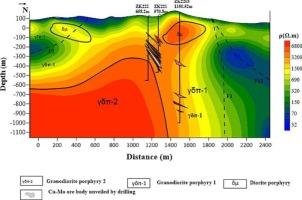深部铜钼斑岩成矿强化预测:基于大地电磁资料二维反演的综合解释
IF 3.6
2区 地球科学
Q1 GEOLOGY
引用次数: 0
摘要
铜和钼是现代工业和绿色能源不可缺少的原材料。不断增长的需求和价格使勘探新的矿产资源成为必要。斑岩型铜钼(Cu-Mo)矿床是这些金属的重要来源,但其深层勘探(>500 m)在研究区仍未得到充分勘探。宝华山地质成分复杂,富含铜钼斑岩。以前的勘探方法难以准确地绘制大量地下资源。为了解决这一问题,本研究利用音频大地电磁(AMT)技术对江苏宝华山深部铜钼斑岩矿床进行了调查,旨在解决这一复杂地质环境下准确表征成矿作用的难题。我们采用AMT方法,通过两条长测量线和50个AMT站点来探索和表征研究区空间的第二空间。我们使用了一种名为watex的机器学习工具来处理数据,过滤了用于收集的初始53个频率,并获得了27个有效频率(10.16 Hz-1032 Hz)。采用自适应移动平均空间滤波对静态偏移进行校正。此外,我们使用OCCAM2D反演完成了横向电(TE)和横向磁(TM)模式的联合反演,两条线的网格为79 x 65个单元,遵循我们使用的正则化因子选择标准。通过稳健的数据处理和反演得到二维模型,增强了指示潜在铜钼矿的电阻率异常的探测和可视化。我们的研究结果揭示了深度超过500 m的明显的中电阻率(~ 2500 Ω.m)构造,可能与Cu-Mo矿床和面向NE-SW和NW-SE的区域断层(F2和F15)有关,其特征是低电阻率。这些发现表明,以前的常规方法无法探测到重要的矿化潜力。提出并实施的3个钻孔证实了矿化的存在。本文章由计算机程序翻译,如有差异,请以英文原文为准。

Enhanced prediction of deep-seated Cu-Mo porphyry mineralization: A comprehensive interpretation based on 2D inversion of audio-magnetotelluric data
Copper and molybdenum are indispensable raw materials for modern industry and green energy. The rising demand and prices necessitate the exploration of new mineral resources. Porphyry copper-molybdenum (Cu-Mo) deposits are crucial suppliers of these metals, yet their deeper exploration (>500 m) remains underexplored in the study area. Baohuashan is known for its intricate geological composition, rich in Cu-Mo porphyry. Previous exploration methods struggled to map extensive underground resources accurately. To solve this problem, this study utilizes Audio-Magnetotelluric (AMT) technology to investigate deep Cu-Mo porphyry deposits in Baohuashan, Jiangsu Province, China, aiming to address the challenges of accurately characterizing mineralization in this complex geological setting. We employed the AMT method, conducting two long survey lines with 50 AMT stations to explore and characterize the second-space of the space of the study area. We used a machine learning tools call watex to process the data, filtered the initial 53 frequencies used to collected and obtained 27 valid frequencies (10.16 Hz-1032 Hz). The adaptive-moving-average spatial filtering has been performed to rectify the static shift. Furthermore, we completed a transverse electric (TE) and transverse magnetic (TM) modes joint inversion using OCCAM2D inversion with a grid of 79 x 65 cells for both lines following a regularization factor selection criterion our parameters used. The two-dimensional models obtained by the robust data processing and inversion enhanced the detection and visualization of resistivity anomalies indicative of potential Cu-Mo deposits. Our results reveal distinct medium-resistivity (∼2500 Ω.m) structures at depths exceeding 500 m, likely associated with Cu-Mo deposits and regional faults (F2 and F15) oriented NE-SW and NW-SE, characterized by low resistivity. These findings suggest significant mineralization potential previously undetected by conventional methods. The presence of mineralization has been confirmed by three drill holes proposed and executed.
求助全文
通过发布文献求助,成功后即可免费获取论文全文。
去求助
来源期刊

Ore Geology Reviews
地学-地质学
CiteScore
6.50
自引率
27.30%
发文量
546
审稿时长
22.9 weeks
期刊介绍:
Ore Geology Reviews aims to familiarize all earth scientists with recent advances in a number of interconnected disciplines related to the study of, and search for, ore deposits. The reviews range from brief to longer contributions, but the journal preferentially publishes manuscripts that fill the niche between the commonly shorter journal articles and the comprehensive book coverages, and thus has a special appeal to many authors and readers.
 求助内容:
求助内容: 应助结果提醒方式:
应助结果提醒方式:


